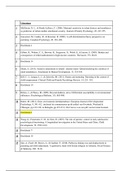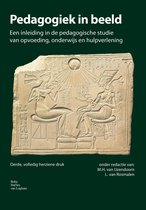Literatuur
1 McElwain, N. L., & Booth-LaForce, C. (2006). Maternal sensitivity to infant distress and nondistress
as predictors of infant-mother attachment security. Journal of Family Psychology, 20, 247-255.
2 Joussemet, M., Landry, R., & Koestner, R. (2008). A self-determination theory perspective on
parenting. Canadian Psychology, 49, 194–200.
3 Hoofdstuk 4
4 Gilbert, R., Widom, C. S., Browne, K., Fergusson, D., Webb, E., & Janson, S. (2009). Burden and
consequences of child maltreatment in high-income countries. The lancet, 373, 68-81.
5 Hoofdstuk 14
6 Meins, E. (2013). Sensitive attunement to infants’ internal states: Operationalizing the construct of
mind-mindedness. Attachment & Human Development, 15, 524-544.
7 Kiff, C. J., Lengua, L. J., & Zalewski, M. (2011). Nature and nurturing: Parenting in the context of
child temperament. Clinical Child and Family Psychology Review, 14, 251- 301.
8 Hoofdstuk 19
9 Belsky, J., & Pluess, M. (2009). Beyond diathesis stress: Differential susceptibility to environmental
influences. Psychological Bulletin, 135, 885-908.
10 Rutter, M. (2012). Gene–environment interdependence. European Journal of Developmental
Psychology, 9, 391-412. (inclusief de commentaren op dit artikel van Overbeek, Weeland &
Chhangur, pp 413-418, en Battaglia, pp 419-431). Zie Canvas voor een pdf van het totale bestand.
11 Hoofdstuk 6
12 Wang, Q., Pomerantz, E. M., & Chen, H. (2007). The role of parents’ control in early adolescents’
psychological functioning: A longitudinal investigation in the United States and China. Child
Development, 78, 1592-1610.
13 Hoofdstuk 7*
14 Hoofdstuk 18
15 Sim, A., Fazel, M., Bowes, L., & Gardner, F. (2018). Pathways linking war and displacement to
parenting and child adjustment: A qualitative study with Syrian refugees in Lebanon. Social Science
& Medicine, 200, 19-26.
,16 Cabrera, N., Fitzgerald, H. E., Bradley, R. H., & Roggman, L. (2014). The ecology of father–child
relationships: An expanded model. Journal of Family Theory & Review, 6, 336–354.
17 Hoofdstuk 9****
* tot hier deeltentamen 1
1 Brody, G. H. (2004). Siblings' direct and indirect contributions to child development. Current
Directions in Psychological Science, 13, 124-126.
2 Kalmijn, M. (2015). How childhood circumstances moderate the long‐term impact of divorce on
father–child relationships. Journal of Marriage and Family, 77, 921−938.
3 Hoofdstuk 13
4 Calzo, J. P., Mays, V. M., Björkenstam, C., Björkenstam, E., Kosidou, K., & Cochran, S. D. (2017).
Parental Sexual Orientation and Children's Psychological Well‐Being: 2013– 2015 National Health
Interview Survey. Child development. Gepubliceerd online.
5 Lamb, M. E. (2012). Mothers, fathers, families, and circumstances: Factors affecting children's
adjustment. Applied Developmental Science, 16, 98-111.
6 Creswell, C., Murray, L., Stacey, J., & Cooper, P. (2011). Parenting and child anxiety. Anxiety
Disorders in Children and Adolescents, 2, 299-322. (t/m pagina 311 “wider parenting practices”) Je
vindt dit artikel op Canvas
7 Stormshak, E. A., Bierman, K. L., McMahon, R. J., & Lengua, L. J. (2000). Parenting practices and
child disruptive behavior problems in early elementary school. Journal of Clinical Child Psychology,
29, 17-29.
8 Hoofdstuk 21*
9 Weisz, J. R., Sandler, I. N., Durlak, J. A., & Anton, B. S. (2005). Promoting and protecting youth
mental health through evidence-based prevention and treatment. American Psychologist, 60, 628-
648.
10 Hoofdstuk 12*
11 van der Put, C. E., Assink, M., Gubbels, J., & van Solinge, N. F. B. (2018). Identifying effective
components of child maltreatment interventions: a meta-analysis. Clinical Child and Family
Psychology Review, 21, 171-202.
, 12 Stattin, H., Enebrink, P., Özdemir, M., & Giannotta, F. (2015). A national evaluation of parenting
programs in Sweden: the short-term effects using an RCT effectiveness design. Journal of Consulting
and Clinical Psychology, 83, 1069-1084.
13 Högström, J., Olofsson, V., Özdemir, M., Enebrink, P., & Stattin, H. (2017). Two-year findings from
a national effectiveness trial: effectiveness of behavioral and nonbehavioral parenting programs.
Journal of Abnormal Child Psychology, 45, 527-542. (alleen de Abstract en de Discussion. Lees dit
artikel ná het artikel van Stattin en collega’s)
14 Leijten, P., Melendez-Torres, G. J., Knerr, W., & Gardner, F. (2016). Transported versus homegrown
parenting interventions for reducing disruptive child behavior: A multilevel meta-regression study.
Journal of the American Academy of Child & Adolescent Psychiatry, 55, 610-617.
15 Hoofdstuk 16*
College 1 (4 febr)
McElwain, N. L., & Booth-LaForce, C. (2006). Maternal sensitivity to
infant distress and nondistress as predictors of infant-mother
attachment security. Journal of Family Psychology, 20, 247-255.
Dit is het eerste onderzoek waarbij de sensitiviteit van moeder vergeleken wordt met
distress en nondistress bij het kind.
Onderzoek: longitudinale studie die de effecten van niet-ouderlijke zorg op de
sociale, emotionele en cognitieve ontwikkeling van kinderen evalueert.
In fase 1 van het NICHD SECC rapporteren moeders over het baby-temperament op
1 en 6 maanden, moeder-kind dyades werden waargenomen in een
semigestructureerde speelsessie in het huis op 6 en 15 maanden en de kindmoeder
gehechtheid werd beoordeeld in de Strange Situation op 15 maanden.
Speelsessies werden gecodeerd voor zowel maternale sensitiviteit voor distress als
voor non distress met behulp van vergelijkbare beoordelingsschalen, waardoor een
unieke kans werd geboden om de relatieve bijdragen van deze twee variabelen aan
de voorspelling van veilige gehechtheid te onderzoeken.
Doel: Door te beoordelen in hoeverre moederlijke sensitiviteit voor distress een
duidelijke voorloper is van vroege gehechtheidsrelaties, kunnen theoretische
voorspellingen over de vorming en ontwikkeling van vroege gehechtheidsrelaties
worden verfijnd en verbeterd.
Daarnaast kunnen interpersoonlijke processen die veilige gehechtheid tijdens de
kleutertijd bevorderen worden afgebakend, en kunnen o.a. gezins artsen in staat
, stellen effectievere therapeutische en preventieve interventies te ontwerpen voor
families van jonge kinderen.
Onderzoek naar:
● De associaties tussen moederlijke sensitiviteit en distress, moederlijke
sensitiviteit en non distress en het moeilijke temperament van het kind.
● De associaties tussen elke sensitiviteit meting en de veilige gehechtheid van
moeder en kind op 15 maanden
● De unieke bijdragen van sensitiviteit van de moeder bij distress en non
distress aan de veilige gehechtheid
Bij de laatste 2 punten werd door moeder gerapporteerd moeilijk temperament van
de baby opgenomen in de analyses om te bepalen of het temperament de
gehechtheid kon voorspellen, en zo ja, of dergelijke associaties significant bleven
wanneer rekening werd gehouden met variabelen van de sensitiviteit.
Vragen:
● In welke mate is de gevoeligheid voor distress en non distress gerelateerd?
Om zowel de gevoeligheid van de moeder ten opzichte van distress als non-distress
in dezelfde context te beoordelen, zou het uitvoeren van langdurige of herhaalde
observaties van moeder-kind interactie vereist zijn, of het onderzoeken van een
subsample van gevallen waarin de mogelijkheid om gevoeligheid voor distress waar
te nemen zich voordeed
● Is de gevoeligheid voor distress gedurende het eerste jaar bijzonder
belangrijk, of blijft het de veiligheid bevorderen tijdens de kindertijd en
daarna?
● Wat is de bijdrage van het kind?
Het moeilijke temperament van een kind kan een indirect effect hebben op de veilige
gehechtheid, voor zover het bijdraagt aan patronen van moeder-kind interacties
Methode:
1364 participanten uit USA. Moeder-kind-dyades werden opgenomen in het huidige
rapport als ze volledige gegevens hadden over de metingen van veilige gehechtheid
op 15 maanden en sensitiviteit van de moeder voor distress en non distress op 6
maanden (n = 357) of 15 maanden (n = 230).
Gemiddelde leeftijd moeders = 28 jaar
Gemiddeld aantal jaar scholing moeders = 14 jaar
Gemiddeld loon = 3x armoedegrens
Omdat veel baby's op elk tijdstip geen stress vertoonden tijdens de moeder-kind
speelsessie, werd de sensitiviteit van de moeder voor distress niet gecodeerd en
daarom werden deze gevallen uitgesloten van de hoofd analyses.





